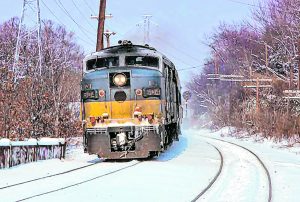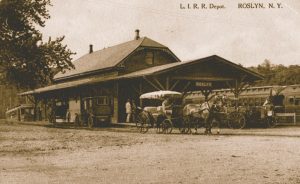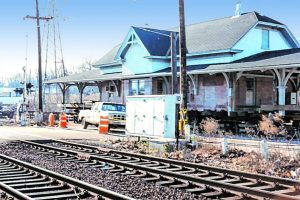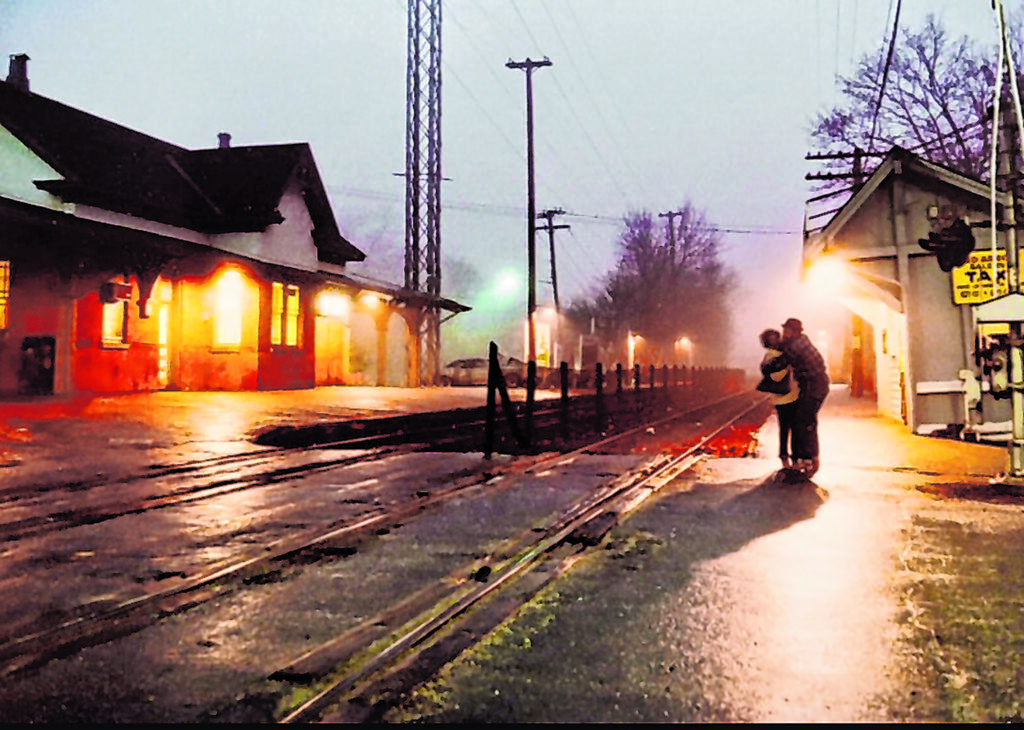By Lauren Feldman and Janet Burns
From delays to rowdy passengers to new routes requiring a transfer, many of us struggle with the transportation entity that is the Long Island Rail Road. However, despite its flaws, the LIRR remains the busiest commuter railroad in North America, carrying approximately 200,000 customers each weekday on 947 daily trains. Currently consisting of 11 branches from Penn Station to Montauk, this mammoth network was first established almost 200 years ago, and is the oldest United States railroad still operating under its original name and charter. Developing such a complex, widespread transportation system has required endurance, hard labor, collaboration, and communication.
Roslyn has both its own rail station, as well as another station south of town, that residents and visitors alike may be familiar with. The history of these stations may be less known, but link developments of the past with dreams for the future.

(Image courtesy of John Schaub archive / trainsarefun.com)
Roslyn Station
Roslyn station was opened on January 23, 1865 by the Glen Cove Branch Rail Road, a subsidiary of the Long Island Rail Road. It is the second stop along the Oyster Bay Branch, which splits from the Port Jefferson central branch at Mineola.
In 1882, the LIRR attempted to extend the former Flushing and North Side Railroad main line from the Great Neck station to the Roslyn station. This proposal dates back to an F&NS subsidiary, called the “Roslyn and Huntington Railroad.” Ultimately this proposal failed, and the line in question extended to Port Washington in 1898, creating what we know today as the Port Washington branch. In the meantime, Roslyn station was moved in order to accommodate a new freight station. The station was rebuilt in a new location between June and July of 1887.

The station house was restored to its 19th-century origins almost 100 years later, in 1981. Then, in 1988, Roslyn Station was moved to the south side of Lincoln Avenue; this project saw the moving of the historic station house to this new location, where it stands today. It opened in July of 1990 with low-level platforms. Construction of the present high-level platforms began on March 3, 1997 and probably was completed in the fall of 1997.
An anonymous Long Islander recalls his experiences as a youth in Roslyn. “When I was a teenager I used to tag along with the conductor on the Oyster Bay freight, which ran every Monday, Wednesday and Friday. The first stop was a lumber yard south of Mineola Coal. There was a layover track there and Mineola Coal was on one side of Jericho Turnpike and on the other side was a large switching area they called ‘the Hole’. In that large complex was Mineola Paper, Albertson Lumber, Local Steel, Mineola Plumbing, Latham Brothers Lumber, Windsor Coal, Pittsburgh Glass, an Iron Works Company, a candy company and another paper company at the end. After spotting cars there, we always took a yellow fruit growers express refrigeration car and put it behind the engine. This was done just about every time on the scheduled run. The fruit growers express refrigeration car was headed to Helena Rubenstein.”

He continues, “We would lay over, either at the Hole or Mineola Coal, and wait for the next north bound train to Oyster Bay. As soon as the block would clear we would follow it up to Roslyn. I remember the conductor telling the engineer to go extremely slow on that siding, something about the curve not being right.”
Albertson Station
Some Roslyn residents may also be familiar with a station slightly further South: Albertson.
First known as Albertson’s in early timetables and other texts, the station was first established as a milk station in early 1874, and then as a flag stop the following summer.
According to the 2018 book Long Island Rail Road: Oyster Bay Branch, by retired LIRR branch manager and railroad historian David Morrison, Albertson is also the station where the first railroad piggyback trains were originated.
According to available historical records, people and/or businesses who were frequenting the station a century and a half ago, during a relative boom-era of agricultural freight on Long Island, were soon calling for a covered shelter to be built, in order to alternately reduce the beating sun or driving snow for those waiting at the stop, just as today’s transit shelters are meant to do.
However, it seems Albertson residents and workers may have had to wait nearly a generation for any sort of covered area.
On May 5, 1887, the Sentinel wrote, under the heading ‘Would Like a Depot’: The people of Albertson Station are very much in need of depot accommodations and intend to present their case to the raildroad officials. It is estimated, we are informed, that for the last ten years, the freight and passenger traffic from this place alone amounts to $10,000 per annum. On this subject a correspondent says: “We have never yet had so much as a roof to cover us or our merchandise and passengers and freight are exposed to the weather, no matter how severe it is.”
It’s hard to know what happened in the next two-to-three decades, as searches of old newspapers didn’t turn up any further such coverage. We do know that a small station depot building was finally completed along IU Willets in Albertson in 1913, which appeared to have fairly wide eaves. It was then razed again in 1954, according to historians, making way for covered trackside shelters and then, since the late ‘90s, raised platforms, shelters, and ticket machines.
































